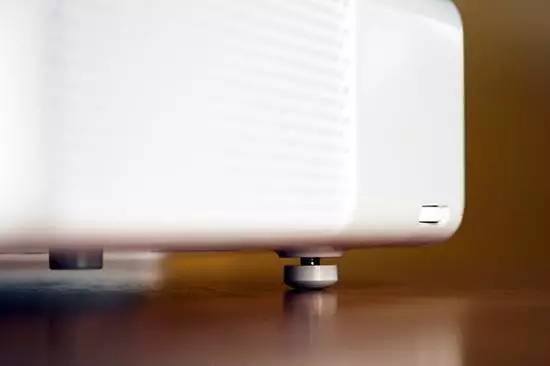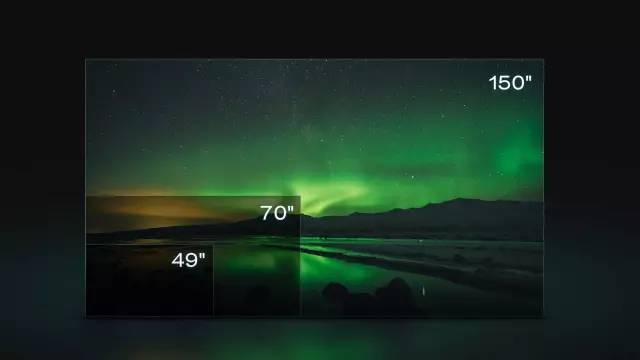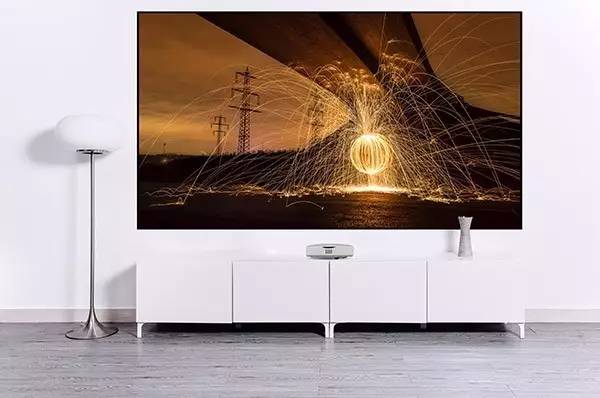OFweek smart home network news at 2:00 pm on June 28, Mi Jia 2017 annual conference officially held. At the press conference, the much-anticipated Mi Jia laser projection TV was unveiled. Laser TVs capable of presenting 150-inch large-screen images are undoubtedly the biggest highlights of the conference.
Of course, the price of 9999 is more than that of other manufacturers on the market, and laser TVs with a high price of more than tens of thousands of yuan are undoubtedly accompanied by lethality. Does that mean that this family of laser televisions in the family can stand out in the market of laser televisions and single-handedly shot out a bloody road. This has to start with Xiaomi's new product.
Maybe it's just beautiful on the surface
First of all, from a design point of view, it can be summed up in one sentence as the most beautiful laser television so far, but the appearance is good, this can not be the only standard to judge its good or bad.
In terms of configuration, this laser TV uses the Amlogic T968 processor, which includes four Cortex-A53 cores clocked at 1.8 GHz and supports 4K source decoding. The product uses a 64-bit architecture with 2GB RAM and 16GB eMMC flash memory. Supports 2.4/5GHz dual-band WiFI, Bluetooth 4.0 and low-power BLE technology. Audio uses 2 full-range speakers and 2 high-frequency speakers for a total of 30W. Dolby 7.1 surround sound decoding and output support. On the whole, there is not much difference between products that have been listed on the market and the highlights are flat.
In the PPT at the conference, we saw that the brightness of the most expensive television light in the history of millet reached 5,000 lumens and the contrast ratio was 3000:1. The Mijia Laser Theater uses an ultra-short focal concave mirror lens. When the product is close to the wall, it can project a 50-inch screen. To project a large 150-inch screen, simply place the mainframe (ultra short-focus laser projector) 50 cm away from the wall. These numbers seem perfect, tall, but in fact, the light source brightness has not been such a standard.

Although the light source is the core component of the projector, the overall brightness of the projector is still affected by factors such as laser technology, DMD chip size, and the overall optical path structure. From the perspective of the body size of the machine and the upstream chip suppliers, the 0.4-inch DMD chip used in this laser TV is a chip that is dedicated to 1080P micro-projection. Its main feature is its low cost, but its brightness and Colors are worse than large-size FHD chips.
The Mi laser projector actually marked a 5000 lumens light source, I do not know how it came, anyway, to really achieve 5000 lumens brightness, 0.47-inch DMD chip is very difficult to achieve.
As a 150-inch large display device, naturally, the resolution is also the focus of everyone's discussion, but in the entire press conference millet did not make too many explanations on the resolution issue, but reflected in the official release of the press conference This is a FullHD 1080p product. Is this the rhythm that consumers want to personally feel after buying it? In machine brother's opinion, the Mi family's evasiveness on the description of the core parameters of the product is a bit irresponsible to consumers.
In addition, we must know that the current market dared to call laser TV brands in order to effectively avoid the impact of the ambient light to the screen are chosen carefully on the anti-light screen, but we see this Mi Jia's laser TV, no direct anti-light screen It is no wonder that the price of 9999 is marked. Although it is much cheaper in terms of price, it also sacrifices the user's experience and is not a permanent solution.

In general, this Mi Jia's laser TV did attract people's attention with the price of 9999, but have to admit that this is just an entry-level product. Combining current consumer trends, consumer's pursuit of entertainment devices has improved, and the prospects of laser televisions have always been favored by manufacturers.
It's not a bad thing that the meter test water laser TV market is not seen. Although there is still a lot of room for improvement in the product and equipment, but recalling the millet 1 of the year, isn't the millet phone today still the focus of the market?
Therefore, the courage to test the water is still commendable. In the future, we must maintain a wait-and-see attitude in the development of laser television. As the Internet rookie brand enters the market, it will inevitably inject new vitality into the traditional laser TV market.
The Practical Significance of Mijia Laser TV
As far as the current development of laser television is concerned, it is mainly divided into two camps: one is traditional TV brands such as Hisense and Changhong, and the other is internet brands represented by millet and nuts.
However, tracing back to the source of laser television, back projection TV as early as in 2000 was its primary form, but at the time its expensive price and brightness color issues had not been resolved, coupled with immense factors such as large size, etc. As a result, rear projection TVs have not been widely used, and development has been extremely slow.
Since 2014, traditional TV makers represented by Hisense, as well as cutting-edge Internet brands such as nuts, have come up with their own solutions to rejuvenate the laser TV market.
However, at present, both traditional and Internet brands, either high or low, or lack user groups, or they turn slowly, or do not understand the mobile Internet, in short, although they are all updating products, but lack of strong voice, powerless To promote the concept of laser television transmission.
The addition of Xiaomi may bring new vigor to the entire market. First of all, Xiaomi has his own user base and also has Internet thinking and powerful voice. Xiaomi knows how to use his own advantages to accumulate users and gain the attention of the users. It is needed by the entire industry.

For Xiaomi, perhaps more is to open the door to the entire laser television industry. The original positioning of laser television is to replace the current large-screen LED/OLED market, and the biggest obstacle for large-screen TV is the screen is too expensive, it is reported that in a TV, the screen cost accounted for more than 80%, but also want What about a bigger television that can think of a home theater? Laser TV began slowly.
Since domestic laser TVs and chips such as Hisense and Changhong are laser light machines and chips imported from abroad, they are inevitably higher in price. After years of market education, many families have heard about laser televisions, but they do The price is right there, and so on, so Xiaomi's ultra-low price just hits the pain point of the consumer, which is also stimulating the demand for laser television.
It can be said that Xiaomi is not merely a promoter in this battle. When the concept of laser television is accepted by more and more people, coupled with the maturity of technology, the cake that Xiaomi will share in the future will also be bigger. This may be the ultimate meaning of Xiaomi's launch of this low-cost laser TV.
In addition, today's mobile phone market has tended to be homogenously saturated. The development of the Mijia Ecological Chain also brings new business growth points to its millet technology.
Laser TV or inevitable?
Laser TV is a high-end projector that adopts ultra-short-focus projection technology as a laser light source. It is not our traditional TV. The first generation of televisions were black-and-white televisions, color televisions, and high-definition televisions. Now they have developed into a fourth-generation laser television-led non-screen television (projection television). Therefore, in terms of technical advantages, laser televisions are not comparable to LED televisions. Ordinary projectors have unparalleled advantages, but the technical advantages can not determine the development prospects.
Laser TV is more like a cross-version upgrade of projection technology. The biggest feature is that the contrast and saturation of the picture are greatly increased, and the effect of ambient light is better, and the ultra-short-focus performance is also more space-saving.
Today's consumers increasingly understand what kind of viewing equipment they want, large screen, high-definition immersive listening experience. The laser television just made up for the shortcomings of LCD TVs in large-scale and gave consumers new choices. This is a typical demand gap.
But one thing I have to admit is that if laser TVs want consumers to turn to themselves, they need to have better performance than TVs, not just better performance than traditional home projectors. However, when compared with flat-panel TVs, some of the shortcomings of laser TVs are evident.

First of all, in any case, laser televisions still belong to projections. They all require the use of the environment and the home environment. The brighter the ambient light, the greater the loss of image quality. TVs almost do not have to consider the influence of ambient light unless the sun shines directly on the screen.
Second, when projecting a large-area screen in theory, the price per unit of size will be much lower than that of a television. However, laser televisions still belong to a very trendy product. The unit price often exceeds several tens of thousands of yuan, not only far exceeds the traditional home projection, but also is much more expensive than the 70-inch LCD TVs, which brings price to consumers. Certain problems.
In addition, the laser TV brands currently on the market are mostly non-mainstream brands or cutting-edge brands. For most consumers, buying such a product that is not very familiar and extremely expensive is also a big task to overcome. Psychological barriers.
These weaknesses are only obvious in laser television. Potential weaknesses include the maturity of the industry, the scale of the industry, the ability to resist risks, the construction of channels, consumer awareness, etc. In these areas, laser television and mature flat-panel TVs There are too many shortcomings. Therefore, individuals think that the audience for laser television is still there, but the future will become the mainstream of television depends on its future development.
Laser TV has obvious advantages. This is also a major reason that can become a hot topic and topic in the market. The laser TV industry is just in the ascendant. With the addition of new Internet brands like Xiaomi, it injects new vitality into the market, plus the traditional brand technology. The guiding role is to believe that the future development of laser TVs will also mature, and manufacturing costs will also be reduced. How will the final market performance be? Let us wait and see!
Insulation Fiberglass Sleeve,Silicone Fiberglass Sleeve,Fiberglass Wire Sleeve,Fiberglass Braided Sleeve
Longkou Libo Insulating Material Co.,Ltd. , https://www.liboinsulation.com